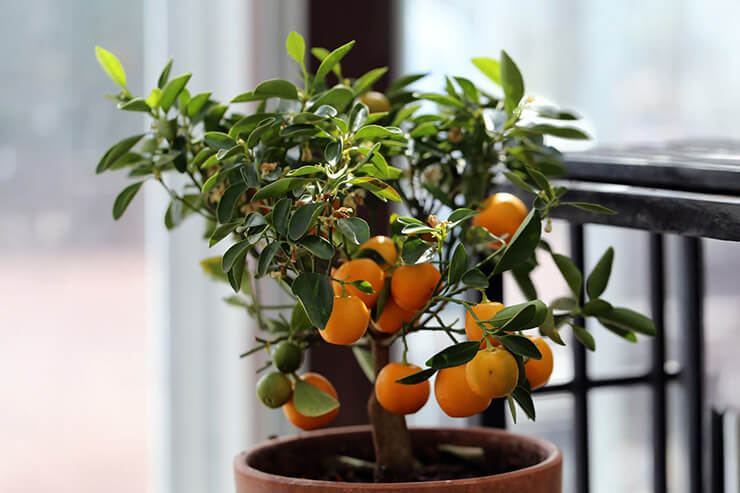Citrus trees bring more than fruit into your home—they bring fragrance, beauty, and a touch of the tropics. Whether it’s the sweet scent of blooming blossoms or the joy of picking your own juicy lemon or orange, growing citrus indoors is one of the most rewarding gardening experiences. Though traditionally grown outdoors in warm climates, many citrus varieties adapt well to life inside, especially when given the right container, lighting, and care.
From lemons and limes to oranges and kumquats, indoor citrus trees offer year-round greenery and seasonal bursts of color and fruit. Compact dwarf varieties are well-suited to containers and can thrive with just a bit of attention to detail. If you’re looking for a plant that gives back in beauty and bounty, citrus is hard to beat.

Soil and pH Preferences
Citrus trees need well-draining soil to thrive, especially in pots where excess water can quickly lead to root rot.
- Soil pH:Citrus prefers slightly acidic conditions, ideally between 5 and 6.5.
- Potting Mix:Choose a high-quality mix formulated for citrus or cactus. A blend of peat, bark, perlite, and sand is ideal.
- Drainage:Ensure the container has drainage holes, and consider adding a layer of gravel or stones at the bottom to help with aeration.
Light Requirements
Citrus trees love the sun—indoors, that means you’ll need to provide consistent and intense light.
- Sunlight Needs:Aim for 8 to 12 hours of light per day.
- Best Light Source:A bright, south-facing window is ideal. If natural light is limited, supplement with a full-spectrum grow light.
- Light Placement:Keep grow lights 6-12 inches above the tree canopy and adjust as needed.
Watering Guidelines
Getting the watering rhythm right is essential for healthy citrus. These trees like a balance—neither soggy nor bone dry.
- Watering Frequency:Water when the top 2 inches of soil feel dry. Typically, once a week works well in moderate conditions.
- Temp:Use room-temperature water and avoid wetting the leaves.
- Humidity:Indoor air is often dry, especially in Winter. Increase humidity around your tree by misting, using a pebble tray, or placing a humidifier nearby.
Best Indoor Growing Environment
Creating a supportive microclimate is key to happy citrus trees indoors.
- Temperature Range:Citrus likes it warm—65-80°F (18-27°C) during the day and no lower than 55°F at night.
- Air Movement:Good airflow helps prevent mildew and encourages pollination. A small fan nearby works wonders.
- Pollination:Most citrus is self-pollinating, but for improved fruit set indoors, you can gently shake the branches or use a soft brush to transfer pollen between blossoms.
- Fertilization:Use a citrus-specific fertilizer every 4-6 weeks during the growing season (Spring to Fall), then reduce feeding in Winter.
5 Tasty Trees for Indoor Gardens
Citrus fruits are packed with vibrant flavor and nutrition. From zesty limes and tangy oranges to candy-sweet kumquats, there’s a citrus variety for every palate. Indoors, these trees serve double duty: they’re both ornamental and edible. Their glossy leaves, fragrant flowers, and colorful fruit make them a standout addition to any indoor space.
Let’s explore five varieties that are perfectly suited for indoor cultivation—each with its own personality and culinary appeal.
Meyer Lemon
A cross between a lemon and a mandarin, the Meyer lemon is slightly sweeter and less acidic than regular lemons. It’s a top pick for indoor growers thanks to its compact size and continuous blooming cycle.
Indoor Benefits:
- Small and well-suited to container life
- Blooms and fruits multiple times per year
- Fragrant blossoms fill your room with citrus scent
Popular Uses:
- Made into lemon curd or pie
- Zested into salad dressings and marinades
- Added to cocktails, teas, or sparkling water
Calamondin Orange
This small, decorative citrus looks like a miniature orange but tastes tart like a lime. Calamondins are incredibly prolific and bear fruit year-round under the right conditions.
Indoor Benefits:
- Excellent fruit-to-size ratio
- Highly ornamental with clusters of bright fruit
- Grows well in 10-14 inch pots
Popular Uses:
- Juiced for sour syrups or marinades
- Used whole (skin and all) in marmalade
- Sliced and added to seafood or poultry dishes
Bearss Lime (Persian Lime)
This seedless lime variety is known for its classic flavor and juicy, acidic fruit. It produces medium-sized, thin-skinned limes perfect for drinks and cooking.
Indoor Benefits:
- Vigorous grower with a compact form
- Fragrant flowers and regular fruiting with good light
- Drought-tolerant once established
Popular Uses:
- Key ingredient in margaritas and mojitos
- Squeezed over tacos or grilled vegetables
- Preserved in salt or sugar
Kaffir Lime
Grown primarily for its aromatic leaves, the Kaffir lime produces bumpy-skinned fruit with a strong citrus aroma. It’s prized in Southeast Asian cooking.
Indoor Benefits:
- Slow-growing and very manageable indoors
- Leaves can be harvested regularly
- Adds exotic flair and fragrance to indoor spaces
Popular Uses:
- Leaves added to Thai soups and curries
- Grated zest used in sauces or spice pastes
- Leaves steeped in herbal teas
Nagami Kumquat
These small, oval fruits are unique among citrus—you eat the whole thing, skin and all. The peel is sweet while the flesh is tangy, creating a delicious contrast.
Indoor Benefits:
- Naturally small tree with dense foliage
- Very productive in containers
- Fruit holds on the tree for weeks, acting as edible decor
Popular Uses:
- Eaten fresh or candied
- Added to salads or grain bowls
- Cooked into chutneys or savory glazes


 Previous
Previous

